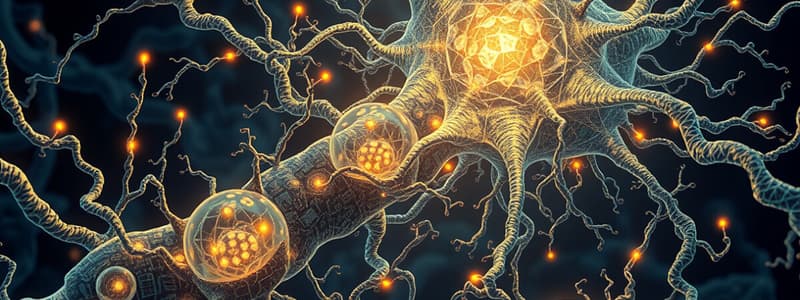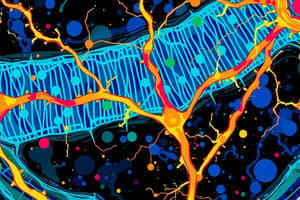Podcast
Questions and Answers
What happens at the axon hillock before propagation of the action potential?
What happens at the axon hillock before propagation of the action potential?
- It converts electrical signals into chemical signals.
- It generates an action potential which propagates down the axon. (correct)
- It stabilizes the resting membrane potential.
- It generates multiple action potentials simultaneously.
What defines conduction velocity in the context of action potential propagation?
What defines conduction velocity in the context of action potential propagation?
- The distance between nodes of Ranvier.
- The time it takes for a neurotransmitter to bind to receptors.
- The strength of the stimulus applied to the neuron.
- The speed at which an action potential is propagated. (correct)
Which factor does NOT affect conduction velocity?
Which factor does NOT affect conduction velocity?
- The presence of myelin insulation.
- The internal resistance of the axon.
- The diameter of the axon.
- The frequency of the action potentials. (correct)
How does myelin affect the propagation of action potentials?
How does myelin affect the propagation of action potentials?
What is the primary function of ion channels in neuronal membranes?
What is the primary function of ion channels in neuronal membranes?
What is the primary reason that larger diameter axons can conduct action potentials faster?
What is the primary reason that larger diameter axons can conduct action potentials faster?
What is the term for the process where action potentials appear to jump along myelinated axons?
What is the term for the process where action potentials appear to jump along myelinated axons?
Which property distinguishes voltage-gated channels from passive channels?
Which property distinguishes voltage-gated channels from passive channels?
How do positive ions affect the membrane potential when sodium channels open?
How do positive ions affect the membrane potential when sodium channels open?
What factor does NOT determine the selectivity of an ion channel?
What factor does NOT determine the selectivity of an ion channel?
During an action potential, what initiates the opening of voltage-gated channels?
During an action potential, what initiates the opening of voltage-gated channels?
Which type of ion channel is primarily responsible for continuous ion flow?
Which type of ion channel is primarily responsible for continuous ion flow?
What is the typical resting membrane potential of a neuronal cell?
What is the typical resting membrane potential of a neuronal cell?
What happens to the potassium channels during a nerve impulse?
What happens to the potassium channels during a nerve impulse?
Which of the following statements about integral proteins is false?
Which of the following statements about integral proteins is false?
What is the typical value for the resting membrane potential?
What is the typical value for the resting membrane potential?
The sodium-potassium pump moves sodium and potassium in which direction relative to their gradients?
The sodium-potassium pump moves sodium and potassium in which direction relative to their gradients?
What provides the energy needed for the sodium-potassium pump to operate?
What provides the energy needed for the sodium-potassium pump to operate?
Where is the action potential generated in a neuron?
Where is the action potential generated in a neuron?
How much does the membrane need to depolarize to reach threshold at the axon hillock?
How much does the membrane need to depolarize to reach threshold at the axon hillock?
What happens if a weak stimulus at the axon hillock does not reach the threshold?
What happens if a weak stimulus at the axon hillock does not reach the threshold?
What is another name for an action potential?
What is another name for an action potential?
Do action potentials always maintain the same amplitude and duration?
Do action potentials always maintain the same amplitude and duration?
What initiates the action potential at the axon hillock?
What initiates the action potential at the axon hillock?
What happens to sodium voltage-gated channels when the threshold is reached?
What happens to sodium voltage-gated channels when the threshold is reached?
During which phase of the action potential is potassium permeability the greatest?
During which phase of the action potential is potassium permeability the greatest?
When does potassium permeability begin to decrease slowly during the action potential?
When does potassium permeability begin to decrease slowly during the action potential?
What is the absolute refractory period?
What is the absolute refractory period?
Why can't a neuron generate another action potential during the absolute refractory period?
Why can't a neuron generate another action potential during the absolute refractory period?
What defines the relative refractory period?
What defines the relative refractory period?
Which diagram phase corresponds to depolarization?
Which diagram phase corresponds to depolarization?
Which option describes hyperpolarization?
Which option describes hyperpolarization?
During which phase does the cell initially begin to repolarize?
During which phase does the cell initially begin to repolarize?
Which of these statements is true about an action potential?
Which of these statements is true about an action potential?
What defines the threshold membrane potential?
What defines the threshold membrane potential?
Which processes interrupt the positive feedback loop during the rising phase of the action potential?
Which processes interrupt the positive feedback loop during the rising phase of the action potential?
What are the two gates associated with voltage-gated sodium channels?
What are the two gates associated with voltage-gated sodium channels?
What occurs at the peak of the action potential regarding voltage-gated sodium channels?
What occurs at the peak of the action potential regarding voltage-gated sodium channels?
When do voltage-gated potassium channels begin to open?
When do voltage-gated potassium channels begin to open?
What results from the opening of voltage-gated potassium channels?
What results from the opening of voltage-gated potassium channels?
What happens during the process of repolarization?
What happens during the process of repolarization?
What is hyperpolarization in relation to the action potential?
What is hyperpolarization in relation to the action potential?
During which phase does sodium permeability increase rapidly?
During which phase does sodium permeability increase rapidly?
During which phase does sodium permeability decrease rapidly?
During which phase does sodium permeability decrease rapidly?
Flashcards are hidden until you start studying
Study Notes
Functions of Cell Membrane Channels
- Ion channels are responsible for controlling the movement of ions across the neuronal membrane.
- Four main properties of ion channels include selectivity, being either passive or active, regional location, and functional uniqueness.
- Ion channels are composed of integral proteins.
Selectivity and Mechanism of Ion Channels
- Selectivity depends on the charge of the ion (positive or negative), the size of the ion, and the ion's ability to attract and hold water.
- Passive ion channels (leakage channels) are always open, while active channels can open or close based on conditions.
Resting Membrane Potential
- The resting neuronal cell membrane is more positive outside than inside, with a typical membrane potential value of -70 mV.
- When at rest, voltage-gated channels are closed; depolarization triggers their opening during an action potential.
Action Potential Dynamics
- An action potential (or nerve impulse) is initiated at the axon hillock, where voltage-gated sodium channels are concentrated.
- Threshold is reached when depolarization of approximately 15 mV occurs, resulting in an all-or-none response.
Ion Channel Behavior During Action Potential
- Sodium voltage-gated channels open rapidly, leading to an increase in sodium permeability; this promotes further depolarization.
- The positive feedback loop sustaining depolarization is interrupted by sodium channel inactivation and potassium channel opening.
- At the peak of the action potential, sodium channels begin inactivation, resulting in reduced inward sodium flow.
Repolarization and Hyperpolarization
- Repolarization occurs when potassium ions exit the cell, decreasing membrane potential toward resting levels.
- Hyperpolarization can happen when potassium channels remain open beyond the resting potential, leading to a more negative value.
Refractory Periods
- The absolute refractory period occurs right after an action potential, during which a new action potential cannot occur due to many inactive sodium channels.
- The relative refractory period allows for the generation of another action potential only if the stimulus is sufficiently strong, due to some inactive sodium channels and open potassium channels.
Action Potential Propagation
- Once initiated, action potentials propagate down the axon through depolarization of adjacent membrane areas.
- Conduction velocity is influenced by axon diameter and myelination; larger diameters and myelination typically increase conduction speed.
- In myelinated axons, action potentials appear to jump between nodes (nodes of Ranvier) in a process called saltatory conduction, enhancing propagation efficiency.
Studying That Suits You
Use AI to generate personalized quizzes and flashcards to suit your learning preferences.




